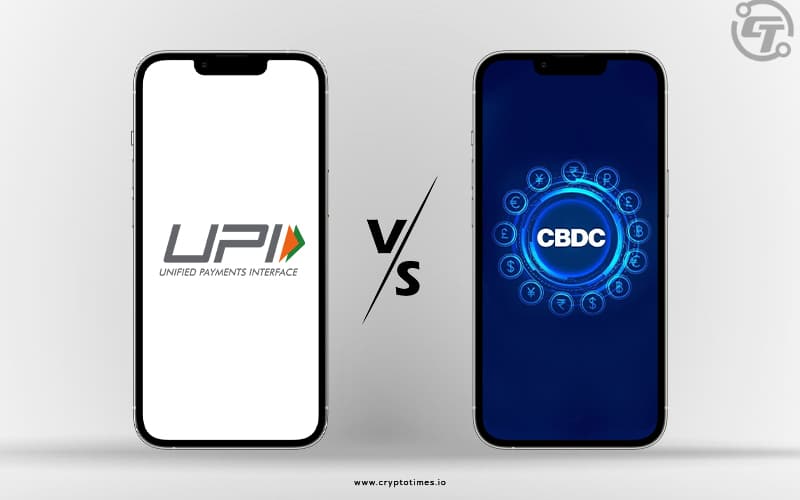Amidst the global exploration of the new financial system, banks and centralized institutions are strategically embracing innovative financial technologies, such as blockchain, to issue digital forms of centralized currency. Generally, this currency is called CBDC, which stands for Centralised Bank Digital Currency.
Digital payment systems have become the dominant mode of payment following the exponential growth of internet users. Despite the continued existence of paper currency, people now overwhelmingly choose online payments as it’s convenient and time-saving, allowing people from any corner of the world to send and receive funds almost instantly.
One of the incredible digital payment modes developed in India, UPI (Unified Payments Interface), came into existence in 2016 and gained a lot of attention worldwide. The UPI project shares many similarities with CBDC, causing doubt about the difference between CBDC and UPI.
Many countries are also testing their CBDC projects, which share functionalities similar to UPI. This similarity makes it challenging to discern the differences between these two seemingly similar financial projects. This article will outline the significant differences between UPI and CBDC, helping you navigate the fundamentals of these similar financial programs. So, let’s start our battle of CBDC vs. UPI.
But before jumping straight to the topic, let’s go through an overview of CBDC and UPI.
What is CBDC?
CBDC, which stands for Central Bank Digital Currency, is the digital form of legal tender issued and regulated by the country’s competent monetary authority, like the central bank, using blockchain technology. Blockchain technology enhances security and grants more transparency to CBDC transactions.
Users require digital wallets to transact CBDC linked to user identities. However, some CBDC projects are also trying to provide anonymity to users so they can easily make peer-to-peer transactions.
CBDC offers abundant benefits over fiat currency, such as improved security, enhanced financial inclusion, cheaper transactions, improved traceability, transparency, and increased resilience of the payment system.
What is the UPI Payment System?
UPI, or Unified Payments Interface, is the real-time interface for digital payments that allows users to transact money between different bank accounts. UPI, developed by the National Payments Corporation of India, is a similar digital payment interface that has made remarkable progress in a short period, revolutionizing the financial landscape of India.
UPI was mainly developed to boost interoperability between different banks. It enables faster bank transfers via a single two-factor authentication process. It has proven to be one of the safest and most secure methods of digital payment.
Furthermore, in the UPI payment system, users do not need to enter bank details every time while making transactions, as they can send money by entering their UPI and password.
Now back to the battle of CBDC vs. UPI.
Differences Between CBDC and UPI
There are numerous differences between CBDC and UPI, which are mentioned below.
1. Issuer and Regulation
While the CBDC is issued and regulated by a country’s central bank, the UPI platform is developed and regulated by the NPCI. However, the Reserve Bank of India (RBI) supervises the entire digital payment system.
2. Purpose and Functionality
The primary purpose of CBDC is to digitalize a country’s paper currency and enhance the experience of digital payments. It boosts the security and accessibility of transactions. Furthermore, CBDC strives to improve financial inclusion, reduce costs, and increase transparency.
On the other hand, UPI was created to accelerate digital payments and financial inclusion in India. The dream its curator has for it is to improve interoperability between different bank accounts. It allows users to make instant payments, transfer funds, pay bills, and even make online purchases.
3. Technology and Integration
For the development and issuance of the CBDC, distributed ledger technology such as blockchain plays a pivotal role. Apart from this, CBDC also uses various technologies to integrate with existing payment systems, banks, and financial infrastructure.
On the flip side, UPI operates on already existing bank infrastructure. It simply uses a mobile application interface and leverages the Immediate Payment Service (IMPS) for real-time fund transfers. Due to this, it has successfully onboarded an enormous number of users. According to the Economic Survey, UPI accounted for 52% of India’s digital transactions in 2022.
4. Adoption and Availability
CBDC is a new concept compared to UPI, and its people will have a long haul before its widespread adoption. Except for a few countries, CBDC projects are still going through pilot testing.
As per the data from the Atlantic Council, only 11 countries have fully launched their CBDC projects, while 21 countries are performing testing and trials.
Surprisingly, Nigeria’s CBDC program, eNaira, has gained attention among all these countries. After the launch of the eNaira in 2021, Nigeria’s central bank now allows bill payments in eNaira.
Conversely, UPI’s popularity and adoption are rapidly growing every day. Since its launch in 2016, UPI has captured the Indian financial world largely, and its dominance in the digital payment system stands at 52%.
According to Worldline’s ‘India Digital Payments Annual Report 2022‘, UPI broke the record by generating an impressive volume of more than 74.05 billion transactions and a value of ₹126 trillion in 2022.
After tasting success in India, many countries are considering integrating UPI into their digital payment systems.
5. Legal Tender
CBDC is considered legal tender, just like physical cash. It can be used for various transactions, including purchases, payments, and settlements, within the jurisdiction where it is issued.
On the other hand, UPI transactions are not considered legal tender. Instead, UPI is a medium to facilitate payments between bank accounts, providing a convenient and interoperable platform for users.
6. Cross-Border Transactions
CBDC has the potential to simplify and streamline cross-border transactions by providing a digital currency that can be used internationally. It could reduce the need for intermediaries.
Also, it can facilitate faster, more efficient, and more secure cross-border payments. Furthermore, the International Monetary Fund is working on a project for the global interoperability of CBDCs.
UPI is primarily designed for domestic transactions within India and does not directly support cross-border payments. However, initiatives like the NPCI’s UPI 2.0 have introduced features that enable linking UPI to other payment systems for cross-border transactions.
7. Privacy and Security
CBDC implementation can include various privacy and security measures. The design of CBDC systems aims to ensure secure transactions, protect user data, and prevent fraud and counterfeiting.
Furthermore, it provides incredible security and transparency for transactions as it uses blockchain technology. However, the level of privacy and security may vary based on the implementation and regulatory framework.
On the other hand, UPI transactions are secured through encryption and authentication protocols, ensuring the privacy and security of user data.
The system incorporates multi-factor authentication, PINs, and other security measures to safeguard transactions. However, users could lose their funds if a device gets compromised or data breaches.
Apart from the differences mentioned above, Reserve Bank of India (RBI) governor Shaktikanta Das has also shared the differences between UPI and India’s CBDC e-rupee following the launch of India’s retail CBDC.
He said that in the case of a UPI transaction, the intermediation of a bank is involved. He explains with the help of an example, “When I use the UPI app, a message goes to my bank, the account gets debited, and the money is transferred to the recipient’s account, where it gets credited—all with the intermediation of the bank.”
However, in the case of CBDC (e-rupee in this case), Das says that it is very similar to paper currency. He explains, “Say you withdraw Rs. 1,000 notes and keep them in your purse. Now, you have to go to the shop and pay Rs 500, so you take it out and pay. Even in CDBC, you withdraw digital currency and keep it in your wallet, which is basically your mobile phone. So, when you go to make a payment in a shop or to another individual, it will go from your wallet to his wallet, but without the intermediation of the bank.”
Summing up:
In a nutshell, both CBDC and UPI were developed to enhance the digital payment system. Despite sharing the same goals, they differ from each other in numerous ways, including technology, adoption, functionality, security, accessibility, cross-border transactions, and more.
Additionally, while CBDC projects have yet to demonstrate their potential to the world, UPI has already gained significant traction in the digital payment system. However, CBDC has the potential to make digital payment systems robust, transparent, and secure by integrating the value of blockchain technology.
FAQs
1. Will CBDC replace UPI?
Currently, it would be early to say that CBDC will completely replace the UPI payment system. Most CBDC projects are in their early stage and require a lot of additional setups like a digital wallet to transact. For general people, it would take time to grasp technology. So, it is not possible that at any moment CBDC can replace UPI.
2. How is CBDC better than UPI?
CBDC leverages DLT (distributed ledger technology) to process transactions that provide higher security, immutability, and transparency. This makes CBDC a more secure and robust payment mode than UPI.
3. Is CBDC and Digital Rupee the same?
Yes, the digital rupee is the Indian central bank digital currency program managed by the Reserve Bank of India (RBI).
4. What is better, CBDC or UPI?
If we look at achievements, then UPI is superior to CBDC, which is still in its trial phase. UPI recently generated 1 billion transactions in a single day which seems unmatchable for CBDC in the nearby future.







